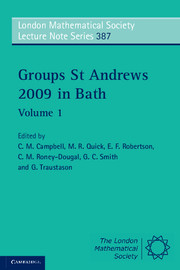Book contents
- Frontmatter
- Contents
- Introduction
- A speech in honour of John Cannon and Derek Holt
- Finite groups of Lie type and their representations
- Iterated monodromy groups
- Engel elements in groups
- Some classes of finite semigroups with kite-like egg-boxes of D-classes
- Structure of finite groups having few conjugacy class sizes
- Group theory in cryptography
- A survey of recent results in groups and orderings: word problems, embeddings and amalgamations
- A survey on the minimum genus and maximum order problems for bordered Klein surfaces
- On one-relator quotients of the modular group
- Miscellaneous results on supersolvable groups
- Automorphisms of products of finite groups
- A rational property of the irreducible characters of a finite group
- Automotives
- On n-abelian groups and their generalizations
- Computing with matrix groups over infinite fields
- Trends in infinite dimensional linear groups
- Engel conditions on orderable groups and in combinatorial problems (a survey)
- References
A survey on the minimum genus and maximum order problems for bordered Klein surfaces
Published online by Cambridge University Press: 05 July 2011
- Frontmatter
- Contents
- Introduction
- A speech in honour of John Cannon and Derek Holt
- Finite groups of Lie type and their representations
- Iterated monodromy groups
- Engel elements in groups
- Some classes of finite semigroups with kite-like egg-boxes of D-classes
- Structure of finite groups having few conjugacy class sizes
- Group theory in cryptography
- A survey of recent results in groups and orderings: word problems, embeddings and amalgamations
- A survey on the minimum genus and maximum order problems for bordered Klein surfaces
- On one-relator quotients of the modular group
- Miscellaneous results on supersolvable groups
- Automorphisms of products of finite groups
- A rational property of the irreducible characters of a finite group
- Automotives
- On n-abelian groups and their generalizations
- Computing with matrix groups over infinite fields
- Trends in infinite dimensional linear groups
- Engel conditions on orderable groups and in combinatorial problems (a survey)
- References
Summary
Abstract
Every finite group acts as a group of automorphisms of some compact bordered Klein surface of algebraic genus g ≥ 2. The same group G may act on different genera and so it is natural to look for the minimum genus on which G acts. This is the minimum genus problem for the group G. On the other hand, for a fixed integer g ≥ 2, there are finitely many abstract groups acting as a group of automorphisms of some compact bordered Klein surface of algebraic genus g. The condition g ≥ 2 assures that all such groups are finite. So it makes sense to look for the largest order of groups G acting on some surface of genus g when g is fixed and G runs over a prescribed family F of groups. This is the maximum order problem for the family F. There is a significant amount of research dealing with these two problems (or with some of their variations), and the corresponding results are scattered in the literature. The purpose of this survey is to gather some of these results, paying special attention to important families of finite groups.
Introduction
A natural extension of the definition of a compact Riemann surface, which is orientable and has no boundary, is to allow dianalytic transition functions, that is, functions which are either analytic or the composite of complex conjugation with an analytic function.
Information
- Type
- Chapter
- Information
- Groups St Andrews 2009 in Bath , pp. 161 - 182Publisher: Cambridge University PressPrint publication year: 2011
References
Accessibility standard: Unknown
Why this information is here
This section outlines the accessibility features of this content - including support for screen readers, full keyboard navigation and high-contrast display options. This may not be relevant for you.Accessibility Information
- 5
- Cited by
